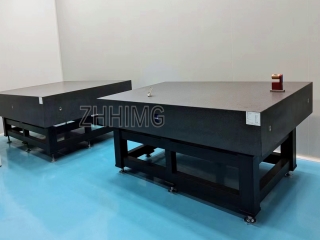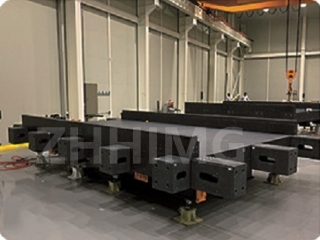In the field of high-end manufacturing, the XYZ precision gantry platform has extremely strict requirements for the performance of materials. Natural granite, with a series of outstanding properties, has become a superior choice over marble.
I. Comparison of Mechanical Properties
Hardness and wear resistance
Granite is mainly composed of minerals such as quartz and feldspar, with a Mohs hardness of 6 to 7. It can effectively resist wear and maintain the surface accuracy of the platform during long-term use and frequent mechanical movements. In contrast, the main component of marble, calcium carbonate, has a relatively low hardness, with a Mohs hardness of only 3 to 5. Under the same friction and pressure, it is more prone to scratches and wear, which affects the accuracy and service life of the platform.
Rigidity and Stability
Granite has a dense structure, with the internal mineral particles closely interlocking, endowing it with excellent rigidity. When subjected to heavy loads and mechanical stresses, it can maintain structural stability and is not prone to deformation. However, marble has a large number of textures and tiny cracks inside, and its rigidity is relatively weak. During high loads or long-term use, it may develop cracks or deformations due to stress concentration, affecting the stability and accuracy of the platform.

Ii. Differences in thermal performance
Coefficient of thermal expansion
Granite has an extremely low coefficient of thermal expansion, approximately 4-8×10⁻⁶/℃, and its size changes very little when the temperature varies. This is crucial for high-precision XYZ precision gantry platforms, which can prevent thermal deformation caused by temperature fluctuations and ensure that the positioning accuracy of the platform is not affected. The coefficient of thermal expansion of marble is relatively high. In an environment with large temperature variations, it is prone to thermal expansion and contraction, which can cause changes in the size and precision of the platform.
Thermal conductivity
Granite has a low thermal conductivity. When heated locally, the heat diffuses slowly, which can reduce the occurrence of thermal deformation. Marble has relatively high thermal conductivity. In application scenarios such as laser processing that generate a large amount of heat, the heat is more likely to be conducted and diffused, resulting in uneven thermal deformation of the platform and affecting the processing accuracy.
Iii. Differences in damping characteristics
Granite has excellent damping properties, and its internal structure can effectively absorb and attenuate vibration energy. During the operation of the gantry platform, vibration can be quickly suppressed, reducing the impact of vibration on processing accuracy and equipment lifespan. The damping performance of marble is relatively weak, making it difficult to rapidly attenuate vibrations like granite, which is not conducive to precision processing operations.
Iv. Chemical Stability Considerations
Granite has strong chemical stability and is resistant to acid and alkali corrosion. In some special processing environments, such as those involving chemical reagents or corrosive gases, granite platforms can maintain the stability of material properties and prevent corrosion. The main component of marble, calcium carbonate, is prone to chemical reactions with acids and is easily corroded in acidic environments, leading to damage to the platform surface and a decrease in accuracy.
V. Service Life and Maintenance Cost
Due to the advantages of granite in terms of hardness, wear resistance and thermal stability, its service life is usually longer than that of marble. Moreover, granite is not prone to wear and tear, has minimal deformation, a long maintenance cycle, and relatively low maintenance costs. Due to issues such as easy wear and poor thermal stability, marble requires more frequent calibration, repair and replacement, resulting in higher maintenance costs.
In conclusion, natural granite outperforms marble in many aspects such as mechanical properties, thermal properties, damping characteristics, chemical stability, service life and maintenance costs. Therefore, it has become the ideal material for XYZ precision gantry platforms.
Post time: Jun-12-2025

